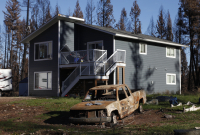Support strong Canadian climate journalism for 2025
Ottawa continues to underinvest in disaster preparedness and mitigation on First Nations despite ballooning recovery costs from the worst wildfire season on record, according to documents shared with Canada’s National Observer.
One document clearly shows Indigenous Services Canada spent three times less preparing for emergencies than in recent years and currently has spent 10 times more than that responding in the same period. This pattern is shown in a Nov. 6 written response by ISC to a query by MP Niki Ashton, NDP Indigenous Services critic. The underfunding of emergency preparedness by ISC is also laid out in three previous audits by the auditor general.
“The results of this upside-down approach should be clear to Canada,” said Ashton to Patty Hajdu, Indigenous Services minister, in a Dec. 5 letter also shared with Canada’s National Observer.
“Indigenous Services Canada cannot continue to rely on Band-Aid solutions to keep First Nations safe,” the letter continues.

The letter addresses other aspects of the audit, including the continued backlog of ISC’s mitigation projects.
There are 112 mitigation projects eligible for funding but still not supported, according to the 2022 audit on emergency preparedness.
So far this year, ISC spent $14.4 million, three times less than the previous three years, on emergency preparedness. The department also spent around half a million on wildland firefighting equipment and training.
In comparison, ISC spent $164 million responding to climate emergencies over the same period.
It’s still unclear how much the department spent on climate mitigation infrastructure this fiscal year, but the previous three years saw an average of $23 million expended.
Questions remain about whether the department will keep up with climate mitigation funding amidst a more restrained federal approach focused on curbing inflation and tackling the deficit.
Since 2015, the federal government spent $789 million on climate responses compared with $388 million on climate mitigation. However, the climate crisis continues to increase response costs as weather events increase the severity and likelihood of catastrophic wildfires and floods.
Canada’s National Observer reporting has shown the disproportionate impacts wildfire has on First Nations. Over 95 First Nations have been evacuated this year alone, which nearly doubles any other wildfire season.
“The AFN [Assembly of First Nations] has been clear that $30.9 billion in climate adaptation funding is needed by 2030, part of a $349.2-billion gap that you promised would be closed by 2030,” said Ashton in the letter to Hajdu.
“We know that climate-related natural disasters are only going to get worse unless we start taking climate change seriously,” she added.
In a previous interview, Minister Hajdu told Canada’s National Observer the federal government is doubling down on the promise of closing the infrastructure gap.
At the AFN general assembly this week, a resolution was drafted to reclaim lands lost due to climate disasters like floods and wildfires.
The resolution calls on Ottawa to work with First Nations to respond immediately to climate emergencies, “including replacing lands that have been lost or damaged and the relocation of reserves vulnerable to climate disasters.”
Ottawa must identify alternative approaches to prioritize the response to climate emergencies impacting First Nations lands, the resolution added.
It’s unclear if one of those alternative approaches includes action on climate mitigation and adaptation to help communities build resiliency against disasters like wildfires and floods.
The resolution draws a parallel to the global loss and damage fund that requires wealthy developed countries to pay into its coffers so vulnerable developing countries can better deal with the destructive impact of climate change.
Lisa Koperqualuk, president of the Inuit Circumpolar Council, is calling for Inuit access to loss and damage funding to pay for climate adaptation in the Arctic, where warming is occurring at over three times the global average.
— With files from John Woodside
Matteo Cimellaro / Canada’s National Observer / Local Journalism Initiative







Comments